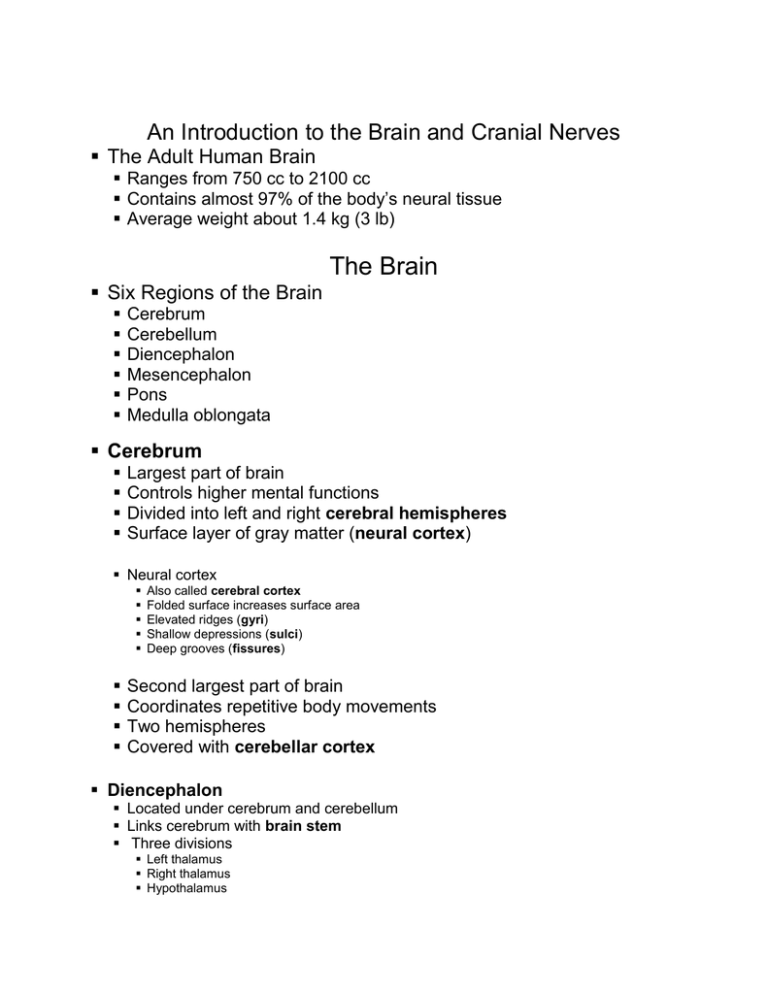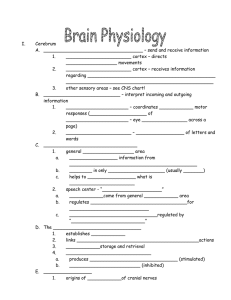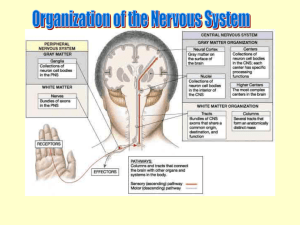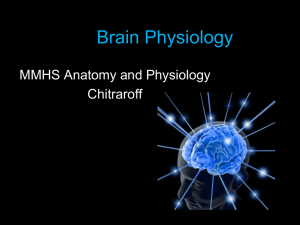An Introduction to the Brain and Cranial Nerves
advertisement

An Introduction to the Brain and Cranial Nerves The Adult Human Brain Ranges from 750 cc to 2100 cc Contains almost 97% of the body’s neural tissue Average weight about 1.4 kg (3 lb) The Brain Six Regions of the Brain Cerebrum Cerebellum Diencephalon Mesencephalon Pons Medulla oblongata Cerebrum Largest part of brain Controls higher mental functions Divided into left and right cerebral hemispheres Surface layer of gray matter (neural cortex) Neural cortex Also called cerebral cortex Folded surface increases surface area Elevated ridges (gyri) Shallow depressions (sulci) Deep grooves (fissures) Second largest part of brain Coordinates repetitive body movements Two hemispheres Covered with cerebellar cortex Diencephalon Located under cerebrum and cerebellum Links cerebrum with brain stem Three divisions Left thalamus Right thalamus Hypothalamus Thalamus Relays and processes sensory information Hypothalamus Hormone production Emotion Autonomic function Pituitary gland Major endocrine gland Connected to hypothalamus Via infundibulum (stalk) Interfaces nervous and endocrine systems The Brain Stem Processes information between Spinal cord and cerebrum or cerebellum Includes Mesencephalon Pons Medulla oblongata Mesencephalon Also called midbrain Processes sight, sound, and associated reflexes Maintains consciousness Pons Connects cerebellum to brain stem Is involved in somatic and visceral motor control Medulla oblongata Connects brain to spinal cord Relays information Regulates autonomic functions: – heart rate, blood pressure, and digestion Embryological Development Determines organization of brain structures Neural tube Origin of brain Enlarges into three primary brain vesicles – prosencephalon – mesencephalon – rhombencephalon Five Secondary Brain Vesicles Telencephalon Diencephalon Mesencephalon Metencephalon Myelencephalon Origins of Brain Structures Diencephalon and mesencephalon persist Telencephalon: Becomes cerebrum Metencephalon Forms cerebellum and pons Myelencephalon Becomes medulla oblongata Ventricles of the Brain Origins of ventricles Neural tube encloses neurocoel Neurocoel expands to form chambers (ventricles) lined with ependymal cells Each cerebral hemisphere contains one large lateral ventricle Separated by a thin medial partition (septum pellucidum) Third ventricle Ventricle of the diencephalon Lateral ventricles communicate with third ventricle: – via interventricular foramen (foramen of Monro) Fourth ventricle Extends into medulla oblongata Becomes continuous with central canal of the spinal cord Connects with third ventricle: – via narrow canal in mesencephalon – aqueduct of midbrain The brain is a large, delicate mass of neural tissue containing internal passageways and chambers filled with cerebrospinal fluid Each of the six major brain regions has specific functions Ascending from the medulla oblongata to the cerebrum, brain functions become more complex and variable Conscious thought and intelligence are produced in the neural cortex of the cerebral hemispheres Brain Protection and Support Physical protection Bones of the cranium Cranial meninges Cerebrospinal fluid Biochemical isolation Blood–brain barrier The Cranial Meninges Have three layers: Dura mater Arachnoid mater Pia mater Are continuous with spinal meninges Protect the brain from cranial trauma Dura mater Inner fibrous layer (meningeal layer) Outer fibrous layer (endosteal layer) fused to periosteum Venous sinuses between two layers Arachnoid mater Covers brain Contacts epithelial layer of dura mater Subarachnoid space: between arachnoid mater and pia mater Pia mater Attached to brain surface by astrocytes Dural Folds Folded inner layer of dura mater Extend into cranial cavity Stabilize and support brain Contain collecting veins (dural sinuses) Falx cerebri, tentorium cerebelli, and falx cerebelli Falx cerebri Projects between the cerebral hemispheres Contains superior sagittal sinus and inferior sagittal sinus Tentorium cerebelli Separates cerebellum and cerebrum Contains transverse sinus Falx cerebelli Divides cerebellar hemispheres below the tentorium cerebelli Cerebrospinal Fluid (CSF) Surrounds all exposed surfaces of CNS Interchanges with interstitial fluid of brain Functions of CSF Cushions delicate neural structures Supports brain Transports nutrients, chemical messengers, and waste products Choroid plexus Specialized ependymal cells and capillaries: – secrete CSF into ventricles – remove waste products from CSF – adjust composition of CSF Produces about 500 mL of CSF/day CSF circulates From choroid plexus Through ventricles To central canal of spinal cord Into subarachnoid space around the brain, spinal cord, and cauda equina CSF in subarachnoid space Arachnoid villi: – extensions of subarachnoid space – extend through dura mater to superior sagittal sinus Arachnoid granulations: – large clusters of villi – absorb CSF into venous circulation Blood Supply to the Brain Supplies nutrients and oxygen to brain Delivered by internal carotid arteries and vertebral arteries Removed from dural sinuses by internal jugular veins Cerebrovascular Disease Disorders interfere with blood circulation to brain Stroke or cerebrovascular accident (CVA) Shuts off blood to portion of brain Neurons die Blood–Brain Barrier Isolates CNS neural tissue from general circulation Formed by network of tight junctions Between endothelial cells of CNS capillaries Lipid-soluble compounds (O2, CO2), steroids, and prostaglandins diffuse into interstitial fluid of brain and spinal cord Astrocytes control blood–brain barrier by releasing chemicals that control permeability of endothelium Blood–CSF Barrier Formed by special ependymal cells Surround capillaries of choroid plexus Limits movement of compounds transferred Allows chemical composition of blood and CSF to differ Four Breaks in the BBB Portions of hypothalamus Secrete hypothalamic hormones Posterior lobe of pituitary gland Secretes hormones ADH and oxytocin Pineal glands Pineal secretions Choroid plexus Where special ependymal cells maintain blood–CSF barrier Meninges stabilize brain in cranial cavity Cerebrospinal fluid protects against sudden movement CSF provides nutrients and removes wastes Blood–brain barrier and blood–CSF barrier Selectively isolate brain from chemicals in blood that might disrupt neural function The Medulla Oblongata Allows brain and spinal cord to communicate Coordinates complex autonomic reflexes Controls visceral functions Nuclei in the Medulla Autonomic nuclei: control visceral activities Sensory and motor nuclei: of cranial nerves Relay stations: along sensory and motor pathways Includes three groups of nuclei Autonomic nuclei Sensory and motor nuclei of cranial nerves Relay stations along sensory and motor pathways Autonomic Nuclei of the Medulla Oblongata Reticular formation Gray matter with embedded nuclei Regulates autonomic functions Reflex centers Control peripheral systems: – cardiovascular centers: ª cardiac center ª control blood flow through peripheral tissues – respiratory rhythmicity centers sets pace for respiratory movements Sensory and Motor Nuclei of the Medulla Oblongata Associated with 5 of 12 cranial nerves (VIII, IX, X, XI, XII) Relay Stations of the Medulla Oblongata Nucleus gracilis and nucleus cuneatus Pass somatic sensory information to thalamus Solitary nucleus Receives visceral sensory information Olivary nuclei (olives) Relay information about somatic motor commands The Pons Links cerebellum with mesencephalon, diencephalon, cerebrum, and spinal cord Sensory and motor nuclei of cranial nerves V, VI, VII, VIII Nuclei involved with respiration Apneustic center and pneumotaxic center: – modify respiratory rhythmicity center activity Nuclei and tracts Process and relay information to and from cerebellum Ascending, descending, and transverse tracts: – transverse fibers (axons): ª link nuclei of pons with opposite cerebellar hemisphere The Cerebellum Functions of the Cerebellum Adjusts postural muscles Fine-tunes conscious and subconscious movements Structures of the Cerebellum Folia Surface of cerebellum Highly folded neural cortex Anterior and posterior lobes Separated by primary fissure Cerebellar hemispheres: Separated at midline by vermis Vermis Narrow band of cortex Flocculonodular lobe Below fourth ventricle Purkinje cells Large, branched cells Found in cerebellar cortex Receive input from up to 200,000 synapses Arbor vitae Highly branched, internal white matter of cerebellum Cerebellar nuclei: embedded in arbor vitae: – relay information to Purkinje cells The peduncles Tracts link cerebellum with brain stem, cerebrum, and spinal cord: – superior cerebellar peduncles – middle cerebellar peduncles – inferior cerebellar peduncles Disorders of the Cerebellum Ataxia Damage from trauma or stroke Intoxication (temporary impairment) Disturbs muscle coordination The Mesencephalon Structures of the Mesencephalon Tectum Two pairs of sensory nuclei (corpora quadrigemina): – superior colliculus (visual) – inferior colliculus (auditory) Tegmentum Red nucleus (many blood vessels) Substantia nigra (pigmented gray matter) Structures of the Mesencephalon Cerebral peduncles Nerve fiber bundles on ventrolateral surfaces Contain: – descending fibers to cerebellum – motor command fibers The Diencephalon Integrates sensory information and motor commands Thalamus, epithalamus, and hypothalamus The pineal gland Found in posterior epithalamus Secretes hormone melatonin The Thalamus Filters ascending sensory information for primary sensory cortex Relays information between basal nuclei and cerebral cortex The third ventricle Separates left thalamus and right thalamus Interthalamic adhesion (or intermediate mass): – projection of gray matter – extends into ventricle from each side Thalamic nuclei Are rounded masses that form thalamus Relay sensory information to basal nuclei and cerebral cortex Five Groups of Thalamic Nuclei Anterior group Anterior nuclei Part of limbic system (emotions) Medial group Provides awareness of emotional states Ventral group Relays sensory information Posterior group Pulvinar nucleus (sensory) Lateral geniculate nucleus (visual) Medial geniculate nucleus (auditory) Lateral group Affects emotional states Integrates sensory information The Hypothalamus Mamillary bodies Process olfactory and other sensory information Control reflex eating movements Infundibulum A narrow stalk Connects hypothalamus to pituitary gland Tuberal area Located between the infundibulum and mamillary bodies Helps control pituitary gland function Eight Functions of the Hypothalamus Provides subconscious control of skeletal muscle Controls autonomic function Coordinates activities of nervous and endocrine systems Secretes hormones Antidiuretic hormone (ADH) by supraoptic nucleus Oxytocin (OT; OXT) by paraventricular nucleus Produces emotions and behavioral drives The feeding center (hunger) The thirst center (thirst) Coordinates voluntary and autonomic functions Regulates body temperature Preoptic area of hypothalamus Controls circadian rhythms (day–night cycles) Suprachiasmatic nucleus The Limbic System The Limbic System Is a functional grouping that Establishes emotional states Links conscious functions of cerebral cortex with autonomic functions of brain stem Facilitates memory storage and retrieval Components of the Limbic System Amygdaloid body Acts as interface between the limbic system, the cerebrum, and various sensory systems Limbic lobe of cerebral hemisphere Cingulate gyrus Dentate gyrus Parahippocampal gyrus Hippocampus Fornix Tract of white matter Connects hippocampus with hypothalamus Anterior nucleus of the thalamus Relays information from mamillary body to cingulate gyrus Reticular formation Stimulation or inhibition affects emotions (rage, fear, pain, sexual arousal, pleasure) The Cerebrum Is the largest part of the brain Controls all conscious thoughts and intellectual functions Processes somatic sensory and motor information Gray matter In cerebral cortex and basal nuclei White matter Deep to basal cortex Around basal nuclei Structures of the Cerebrum Gyri of neural cortex Increase surface area (number of cortical neurons) Insula (island) of cortex Lies medial to lateral sulcus Longitudinal fissure Separates cerebral hemispheres Lobes Divisions of hemispheres Central sulcus divides Anterior frontal lobe from posterior parietal lobe Lateral sulcus divides Frontal lobe from temporal lobe Parieto-occipital sulcus divides Parietal lobe from occipital lobe Three Functional Principles of the Cerebrum Each cerebral hemisphere receives sensory information from, and sends motor commands to, the opposite side of the body The two hemispheres have different functions, although their structures are alike Correspondence between a specific function and a specific region of cerebral cortex is not precise White Matter of the Cerebrum Association fibers Commissural fibers Projection fibers Association fibers Connections within one hemisphere: – arcuate fibers: ª are short fibers ª connect one gyrus to another – longitudinal fasciculi: ª are longer bundles ª connect frontal lobe to other lobes in same hemisphere Commissural fibers Bands of fibers connecting two hemispheres: – corpus callosum – anterior commissure Projection fibers Pass through diencephalon Link cerebral cortex with: – diencephalon, brain stem, cerebellum, and spinal cord Internal capsule: – all ascending and descending projection fibers The Basal Nuclei Also called cerebral nuclei Are masses of gray matter Are embedded in white matter of cerebrum Direct subconscious activities Structures of Basal Nuclei Caudate nucleus Curving, slender tail Lentiform nucleus Globus pallidus Putamen Functions of Basal Nuclei Involved with The subconscious control of skeletal muscle tone The coordination of learned movement patterns (walking, lifting) Motor and Sensory Areas of the Cortex Central sulcus separates motor and sensory areas Motor areas Precentral gyrus of frontal lobe: – directs voluntary movements Primary motor cortex: – is the surface of precentral gyrus Pyramidal cells: – are neurons of primary motor cortex Sensory areas Postcentral gyrus of parietal lobe: – receives somatic sensory information (touch, pressure, pain, vibration, taste, and temperature) Primary sensory cortex: – surface of postcentral gyrus Special Sensory Cortexes Visual cortex Information from sight receptors Auditory cortex Information from sound receptors Olfactory cortex Information from odor receptors Gustatory cortex Information from taste receptors Association Areas Sensory association areas Monitor and interpret arriving information at sensory areas of cortex Somatic motor association area (premotor cortex) Coordinates motor responses (learned movements) \Somatic sensory association area Interprets input to primary sensory cortex (e.g., recognizes and responds to touch) Visual association area Interprets activity in visual cortex Auditory association area Monitors auditory cortex Integrative Centers Are located in lobes and cortical areas of both cerebral hemispheres Receive information from association areas Direct complex motor or analytical activities General Interpretive Area Also called Wernicke area Present in only one hemisphere Receives information from all sensory association areas Coordinates access to complex visual and auditory memories Other Integrative Areas Speech center Is associated with general interpretive area Coordinates all vocalization functions Prefrontal cortex of frontal lobe Integrates information from sensory association areas Performs abstract intellectual activities (e.g., predicting consequences of actions) Interpretive Areas of Cortex Brodmann areas Patterns of cellular organization in cerebral cortex Hemispheric Lateralization Functional differences between left and right hemispheres Each cerebral hemisphere performs certain functions that are not ordinarily performed by the opposite hemisphere The Left Hemisphere In most people, left brain (dominant hemisphere) controls Reading, writing, and math Decision making Speech and language The Right Hemisphere Right cerebral hemisphere relates to Senses (touch, smell, sight, taste, feel) Recognition (faces, voice inflections) Monitoring Brain Activity Brain activity is assessed by an electroencephalogram (EEG) Electrodes are placed on the skull Patterns of electrical activity (brain waves) are printed out Four Categories of Brain Waves Alpha waves Found in healthy, awake adults at rest with eyes closed Beta waves Higher frequency Found in adults concentrating or mentally stressed Theta waves Found in children Found in intensely frustrated adults May indicate brain disorder in adults Delta waves During sleep Found in awake adults with brain damage Synchronization A pacemaker mechanism Synchronizes electrical activity between hemispheres Brain damage can cause desynchronization Seizure Is a temporary cerebral disorder Changes the electroencephalogram Symptoms depend on regions affected Cranial Nerves 12 pairs connected to brain Four Classifications of Cranial Nerves Sensory nerves: carry somatic sensory information, including touch, pressure, vibration, temperature, and pain Special sensory nerves: carry sensations such as smell, sight, hearing, balance Motor nerves: axons of somatic motor neurons Mixed nerves: mixture of motor and sensory fibers Cranial nerves are classified by primary functions May also have important secondary functions Distributing autonomic fibers to peripheral ganglia The 12 cranial nerve groups are identified by Primary function Origin Pathway Destination Olfactory Nerves (I) Primary function Special sensory (smell) Origin Receptors of olfactory epithelium Pathway Olfactory foramina in cribriform plate of ethmoid Destination Olfactory bulbs Olfactory Nerve Structures Olfactory bulbs Located on either side of crista galli Olfactory tracts Axons of postsynaptic neurons Leading to cerebrum Optic Nerves (II) Primary function Special sensory (vision) Origin Retina of eye Pathway Optic canals of sphenoid Destination Diencephalon via optic chiasm Optic Nerve Structures Optic chiasm Where sensory fibers converge And cross to opposite side of brain Optic tracts Reorganized axons Leading to lateral geniculate nuclei Oculomotor Nerves (III) Primary function Motor (eye movements) Origin Mesencephalon Pathway Superior orbital fissures of sphenoid Destination Somatic motor: – superior, inferior, and medial rectus muscles – inferior oblique muscle – levator palpebrae superioris muscle Visceral motor: – intrinsic eye muscles Oculomotor Nerve Structures Oculomotor nerve Controls four of six eye-movement muscles Delivers autonomic fibers to ciliary ganglion: – ciliary ganglion: controls intrinsic muscles of iris and lens The Trochlear Nerves (IV) Primary function Motor (eye movements) Origin Mesencephalon Pathway Superior orbital fissure of sphenoid Destination Superior oblique muscle The Abducens Nerves (VI) Primary function Motor (eye movements) Origin Pons Pathway Superior orbital fissures of sphenoid Destination Lateral rectus muscle The Trigeminal Nerves (V) Primary function Mixed (sensory and motor) to face Origin Ophthalmic branch (sensory): – – – – orbital structures nasal cavity skin of forehead, upper eyelid, and eyebrow part of nose Maxillary branch (sensory): – – – – lower eyelid upper lip, gums, and teeth cheek and nose palate and part of pharynx Mandibular branch (sensory): – lower gums, teeth, and lips – palate and part of tongue Mandibular branch (motor): – motor nuclei of pons Pathway Ophthalmic branch: – superior orbital fissure Maxillary branch: – foramen rotundum Mandibular branch: – foramen ovale Destination Sensory nerves: – sensory nuclei in pons Motor nerves of mandibular branch: – muscles of mastication Trigeminal Nerve Structures Trigeminal nerves Largest cranial nerves With three major branches Semilunar ganglion Contains cell bodies of sensory neurons The Facial Nerves (VII) Primary function Mixed (sensory and motor) to face Origin Sensory: – taste receptors on anterior 2/3 of tongue Motor: – motor nuclei of pons Pathway Internal acoustic meatus to facial canals (stylomastoid foramina) Destination Sensory: – sensory nuclei of pons Somatic motor: – muscles of facial expression Visceral motor: – tear and nasal mucous glands – submandibular and sublingual salivary glands Facial Nerve Structures Facial nerve branches Temporal Zygomatic Buccal Mandibular Cervical branches Geniculate ganglia Hold cell bodies of sensory neurons Pterygopalatine ganglia Postganglionic fibers innervate glands (lacrimal, nasal cavity, and pharynx) Submandibular ganglia Innervate salivary glands The Vestibulocochlear Nerves (VIII) Primary function: special sensory Vestibular branch: – balance and equilibrium Cochlear branch: – hearing Origin Receptors of inner ear Pathway Internal acoustic meatus of temporal bones Destination Vestibular and cochlear nuclei of pons and medulla oblongata Vestibulocochlear Nerve Structures Vestibular branch Originates at receptors of vestibule (balance) Connects to vestibular nuclei of pons and medulla oblongata Cochlear branch Originates at sensors of cochlea (hearing) Connects with cochlear nuclei of pons and medulla oblongata The Glossopharyngeal Nerves (IX) Primary function Mixed (sensory and motor) to head and neck Origins Sensory: – posterior 1/3 of tongue – part of pharynx and palate – carotid arteries Motor: – motor nuclei of medulla oblongata Pathway Jugular foramina between occipital and temporal bones Destination Sensory: – sensory nuclei of medulla oblongata Somatic motor: – nerves involved in swallowing Visceral motor: – parotid salivary gland Superior and inferior ganglion Sensory neurons of tongue and pharynx Otic ganglion Synapse visceral motor fibers The Vagus Nerves (X) Primary function Mixed (sensory and motor) Widely distributed in thorax and abdomen Origins Sensory: – – – – part of pharynx auricle and external acoustic meatus diaphragm visceral organs of thoracic and abdominopelvic cavities Motor: – motor nuclei in medulla oblongata Pathway Jugular foramina Between occipital and temporal bones Destination Sensory: – sensory nuclei and autonomic centers of medulla oblongata Visceral motor: – muscles of the palate and pharynx – muscles of the digestive, respiratory, and cardiovascular systems in thoracic and abdominal cavities Vagus Nerve Structures Vagus nerves Branch and radiate extensively Superior (jugular) ganglion and inferior (nodose) ganglion Hold sensory neurons The Accessory Nerves (XI) Primary function Motor to muscles of neck and upper back Origin Motor nuclei of spinal cord and medulla oblongata Pathway Jugular foramina between occipital and temporal bones Destination Internal branch: – voluntary muscles of palate, pharynx, and larynx External branch: – sternocleidomastoid and trapezius muscles Accessory Nerve Structures Spinal root Motor fibers that originate in anterior gray horns of first five cervical segments of spinal cord Cranial root Motor fibers that originate in medulla oblongata Internal branch Joins the vagus nerve External branch Controls muscles of neck and back The Hypoglossal Nerves (XII) Primary function Motor (tongue movements) Origin Motor nuclei of medulla oblongata Pathway Hypoglossal canals of occipital bone Destination Muscles of tongue Cranial Reflexes Cranial Reflexes Monosynaptic and polysynaptic reflex arcs Involve sensory and motor fibers of cranial nerves Clinically useful to check cranial nerve or brain damage



